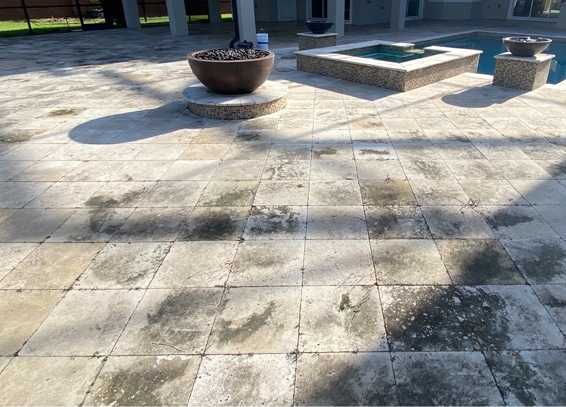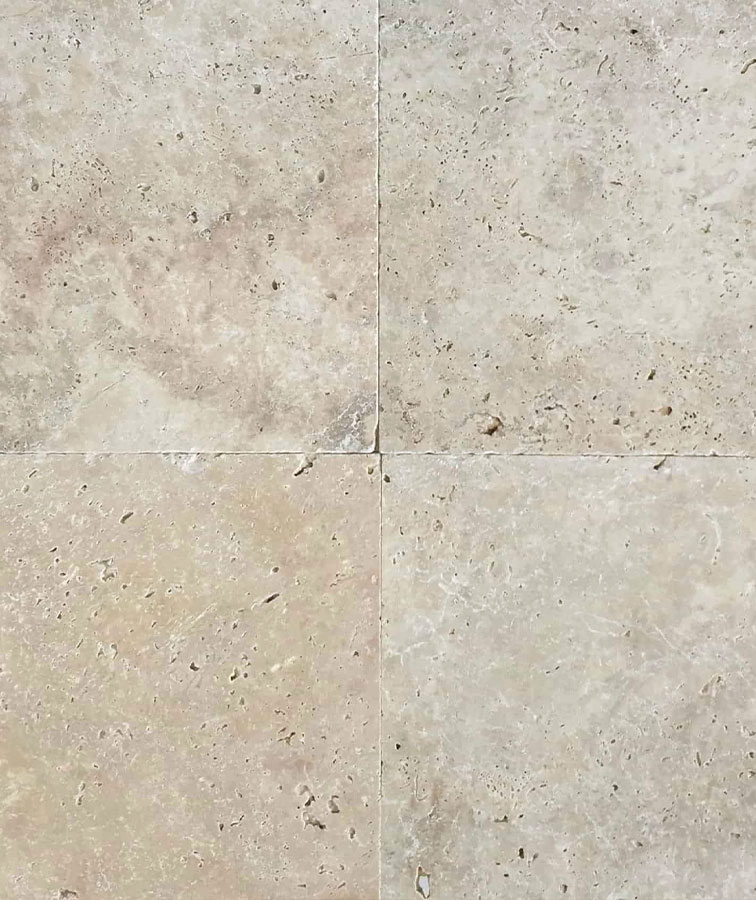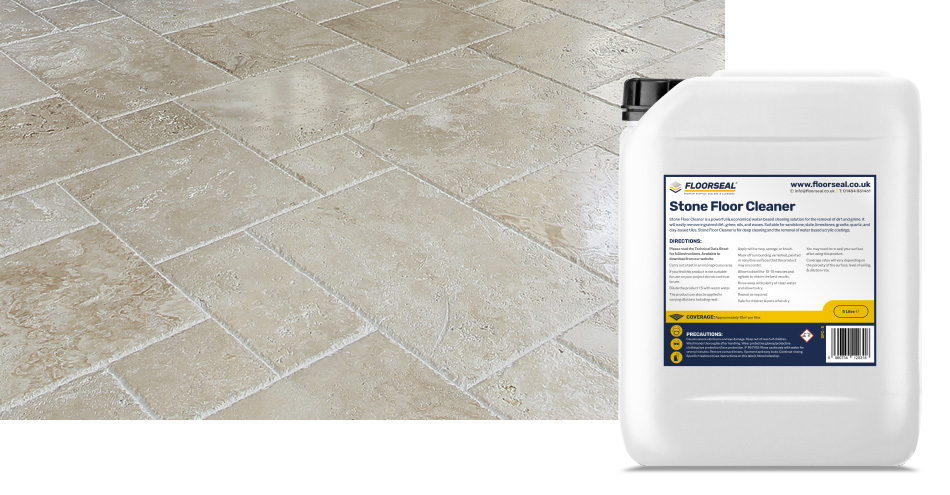Cleaning travertine pavers can seem daunting. But, it’s easier than you think.
Travertine pavers add elegance to any outdoor space. Over time, dirt and stains can dull their beauty. Knowing how to clean them is key. Proper maintenance not only enhances their appearance but also extends their life. This guide will help you clean your travertine pavers effectively.
We will cover simple and safe methods. You don’t need fancy tools. With a few steps, your pavers can look new again. Ready to make your outdoor space shine? Let’s get started.

Credit: eaglepavers.us
Materials Needed
Keeping your travertine pavers clean enhances their look and extends their lifespan. Proper cleaning ensures your pavers remain beautiful and durable. To get started, gather the right materials. Below, we break down the essentials you need.
Essential Cleaning Tools
- Broom or leaf blower – For removing loose dirt and debris.
- Garden hose – To rinse the pavers with water.
- Soft-bristle brush – For scrubbing without damaging the surface.
- Bucket – To hold your cleaning solution.
- Microfiber cloth – For drying and polishing the pavers.
Recommended Cleaning Solutions
Choosing the right cleaning solution is crucial for maintaining travertine pavers. Here are some options:
- Mild dish soap and water – A simple solution for regular cleaning.
- Stone-specific cleaner – Designed for natural stones like travertine.
- pH-neutral cleaner – Safe for sensitive stone surfaces.
- Oxygen bleach – For tougher stains without harming the stone.
By using these materials, you can keep your travertine pavers in top shape. Regular cleaning prevents stains and maintains their natural beauty.

Credit: travertine-tiles-pavers.com.au
Initial Preparation
Cleaning travertine pavers starts with careful preparation. Proper initial steps ensure a thorough and safe cleaning process. This phase involves two key tasks: clearing the area and inspecting for damage.
Clearing The Area
First, remove any furniture from the pavers. Move planters and garden tools as well. Clear the space of any debris. This includes fallen leaves and twigs. Use a broom or leaf blower to sweep the area. Ensure nothing is left on the pavers. This makes the cleaning process easier and more efficient.
Inspecting For Damage
Next, inspect the travertine pavers for damage. Look for cracks or chips. Check for any loose pavers. Examine the grout lines for wear and tear. Note any problem areas that might need repair. This inspection helps avoid further damage during cleaning. It’s essential for maintaining the pavers’ longevity and appearance.
Dry Cleaning Techniques
Maintaining the beauty of your travertine pavers is essential. Regular dry cleaning prevents dirt buildup and extends their lifespan. Here are some effective dry cleaning techniques.
Sweeping And Blowing Debris
Sweeping is a simple way to remove loose dirt and debris. Use a broom with stiff bristles for the best results. Sweep in one direction to collect debris into a pile. Then, dispose of the collected debris properly.
For larger areas, consider using a leaf blower. Leaf blowers can quickly clear away leaves, dust, and small particles. Hold the blower at a low angle. This ensures that debris moves away from the pavers without causing damage.
Using A Dry Mop
A dry mop can help remove fine dust and dirt. Choose a mop with a microfiber head. Microfiber traps dust and dirt particles effectively. Glide the mop over the surface in smooth strokes. This technique is gentle and safe for travertine pavers.
Regularly shake out the mop head to remove collected dust. Replace the mop head when it becomes too dirty. This ensures the mop remains effective in cleaning your pavers.
Wet Cleaning Methods
Clean travertine pavers using gentle wet cleaning methods. Start by rinsing the surface with water. Use a mild soap solution and a soft brush for scrubbing.
Cleaning travertine pavers can seem like a daunting task. But with the right wet cleaning methods, it becomes easy. Wet cleaning methods help remove deep-seated dirt. They also ensure your pavers look fresh and clean.Mild Soap And Water Solution
A mild soap and water solution works wonders. Mix a few drops of mild soap with warm water. Use a soft-bristle brush to scrub the pavers. This helps remove grime and stains. Rinse the pavers well with clean water. Let them dry completely. This method is gentle and effective.Pressure Washing Tips
Pressure washing is another effective method. Use a pressure washer with a low PSI setting. High pressure can damage the pavers. Keep the nozzle at least one foot from the surface. Move the washer in a sweeping motion. This prevents streaks and ensures an even clean. After washing, let the pavers dry completely. This method is fast and efficient. “`Stain Removal
Stain Removal is a crucial step in maintaining the beauty of your travertine pavers. Over time, various elements can stain your pavers, making them look dull and unattractive. Removing these stains effectively requires understanding the type of stain and using the right products. This section will guide you through identifying stains and selecting effective stain removal products.
Identifying Stains
Different stains require different treatments. Common stains on travertine pavers include oil, rust, and organic stains. Oil stains often come from food or vehicle leaks. Rust stains result from metal furniture or tools left on the pavers. Organic stains usually come from leaves, flowers, or bird droppings.
Identifying the type of stain is the first step in the cleaning process. Look closely at the stain’s color and texture. Oil stains appear dark and greasy. Rust stains have a reddish-brown color. Organic stains are usually green or brown.
Effective Stain Removal Products
Using the right products is essential for removing stains from travertine pavers. Here are some effective products for different types of stains:
| Type of Stain | Recommended Product |
|---|---|
| Oil Stains | Degreaser or dish soap |
| Rust Stains | Rust remover or oxalic acid |
| Organic Stains | Hydrogen peroxide or bleach |
For oil stains, apply a degreaser or dish soap directly to the stain. Let it sit for a few minutes, then scrub with a brush. Rinse thoroughly with water.
To remove rust stains, use a rust remover or oxalic acid. Apply the product to the stain and let it work for the recommended time. Scrub gently and rinse well with water.
For organic stains, hydrogen peroxide or bleach works well. Apply the product to the stain and let it sit for a few minutes. Scrub lightly and rinse with water.
Always test any product on a small, hidden area first. This ensures it does not damage the pavers. Follow the manufacturer’s instructions for the best results.

Credit: floorseal.co.uk
Sealing Travertine Pavers
Sealing travertine pavers is essential to protect them from stains and damage. This process helps to maintain the pavers’ natural beauty and durability. Let’s explore the steps to effectively seal your travertine pavers.
Choosing The Right Sealer
Selecting the appropriate sealer is crucial for long-lasting protection. There are two main types of sealers: penetrating sealers and surface sealers.
- Penetrating Sealers: These sealers absorb into the stone, providing deep protection. They are ideal for areas with high foot traffic.
- Surface Sealers: These sealers form a protective layer on top of the pavers. They enhance the stone’s appearance and are suitable for decorative areas.
Consider the location and usage of your pavers before choosing a sealer. For outdoor areas, opt for a sealer with UV protection. For indoor areas, a clear, water-based sealer works well.
Step-by-step Sealing Process
Follow these steps to seal your travertine pavers effectively:
- Clean the Pavers: Remove dirt and debris using a broom or a vacuum.
- Wash the Pavers: Use a mild detergent and water to wash the pavers. Rinse thoroughly and let them dry completely.
- Apply the Sealer: Use a paint roller or brush to apply the sealer evenly. Follow the manufacturer’s instructions for the best results.
- Allow to Dry: Let the sealer dry for the recommended time. This usually takes 24 to 48 hours.
- Reapply if Needed: For enhanced protection, apply a second coat of sealer. Ensure the first coat is completely dry before reapplying.
Regular maintenance and resealing every few years will keep your travertine pavers in excellent condition. By following these steps, you ensure your pavers remain beautiful and protected for years to come.
Regular Maintenance
Regular maintenance keeps your travertine pavers looking fresh and clean. It also extends their lifespan. Let’s explore some effective ways to maintain these beautiful stones.
Routine Cleaning Schedule
Establish a routine cleaning schedule for your travertine pavers. Sweep the surface weekly to remove dirt and debris. Use a soft-bristle broom to avoid scratches. For deeper cleaning, use a mild soap and water solution. Rinse thoroughly with clean water.
During the rainy season, increase the frequency of cleaning. Excess water can lead to staining. Dry the pavers with a soft cloth after rinsing. This helps prevent water spots.
Preventive Measures
Preventive measures can save you time and effort. Seal your travertine pavers every two to three years. A good sealant protects against stains and moisture. Apply the sealant on a clean and dry surface. Follow the manufacturer’s instructions for best results.
Place mats at entry points to reduce dirt. Avoid using harsh chemicals for cleaning. They can damage the stone. Use only pH-neutral cleaners designed for travertine.
Trim nearby plants to avoid leaf litter. Leaves and organic matter can cause stains. Clean spills immediately to prevent staining. Use a cloth to blot the spill, not rub it.
Troubleshooting Common Issues
Cleaning travertine pavers can sometimes present challenges. You may encounter issues such as mold, mildew, or efflorescence. Addressing these problems early helps maintain the beauty of your pavers.
Dealing With Mold And Mildew
Mold and mildew thrive in damp environments. They can make your travertine pavers look dirty and unkempt. Regular cleaning helps prevent their growth. Use a mixture of water and mild detergent. Scrub the affected area with a soft brush. Rinse with clean water and let it dry completely. For stubborn mold, consider using a stone-safe mold remover.
Addressing Efflorescence
Efflorescence appears as a white, powdery substance on the pavers’ surface. It occurs when water moves through the stone, bringing minerals to the surface. To remove efflorescence, use a stiff brush to scrub the area. Rinse with clean water to wash away the residue. If the problem persists, use a stone-safe efflorescence remover.
Frequently Asked Questions
How Often Should I Clean Travertine Pavers?
Clean travertine pavers every three months. This keeps them looking good and prevents damage.
What Tools Do I Need To Clean Travertine Pavers?
Use a broom, mild detergent, water, and a soft brush. Avoid harsh chemicals.
Can I Use A Pressure Washer On Travertine Pavers?
Yes, but use a low setting. High pressure can damage the stone.
How Do I Remove Stains From Travertine Pavers?
Use a mixture of water and mild soap. Scrub gently with a soft brush.
Should I Seal My Travertine Pavers?
Yes, sealing protects the stone. Do it every one or two years for best results.
Conclusion
Regular cleaning keeps travertine pavers looking beautiful. Follow these simple steps. Sweep or rinse to remove dirt. Use mild soap and water for stains. Avoid harsh chemicals. Seal pavers to protect them. Regular maintenance prevents damage. Clean spills immediately to avoid stains.
Enjoy your spotless travertine pavers.
